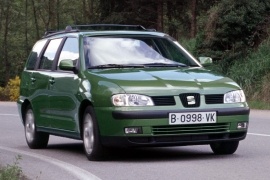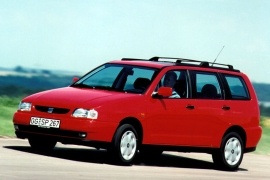SEAT Cordoba Vario Models/Series Timeline, Specifications & Photos
First production year: 1996
Engines: Gasoline, Diesel
Body style: Wagon (station wagon, estate, combi, touring)
Three years after introducing the Cordoba station wagon model, the Spanish carmaker unveiled the entire range's facelifted version.
While the station wagon version didn't need a refresh after just three years, the rest of the range did since it was already six years old. When SEAT launched the Cordoba range in 1993, it didn't have enough money to build a complete range, so it had to wait another three years to introduce its small-segment station wagon. By the time it launched, its look was already old, and the 1999 refresh fixed that.
The 1999 model featured softer edges and some curved lines over the bodywork. Its headlights sported a curve on their upper side, while its predecessor featured rectangular ones. In search of its brand image, the carmaker introduced a new badge at the front, surrounded by a body-colored surrounding. The bumper was new and featured squared fog lights instead of the round ones. SEAT introduced the body-colored door handles, upgrading the side-view look. In the back, the carmaker changed the bumper and added a black rubber band.
Inside, the carmaker introduced a completely new dashboard with better integration for the ventilation system and smooth vents on top of the center stack. Inside the instrument cluster, SEAT adopted Volkswagen's style for the dials, with the temperature and fuel gauges installed in the middle and panel's upper side.
SEAT offered the Cordoba with a choice of seven engines, both gasoline, and diesel, ranged between 68 hp and 110 hp. All engines were paired with a five-speed manual.
Seat introduced the first generation of Cordoba in 1993, and three years later, it was available as a station-wagon version, named Vario.
After successfully launching the second generation of the Ibiza lineup, the Spanish carmaker introduced a three-box version named Cordoba. They shared the same platform with the Polo. But the German carmaker, who already owned the Spanish brand, decided to postpone the station-wagon version and launch it in 1996 along with the facelifted version for the entire Cordoba range.
On the outside, the small-segment wagon featured Polo-like horizontal headlights and a grille that looked like a smile. It was their way to show a car that could improve people's life. The time of station-wagons was not past due, and a vehicle with enough interior room as a compact-sized vehicle was good news. While the front of the car was similar to the three-box Cordoba, after the B-pillar, the designers made a more extended roof and, behind the C-pillars, they placed a set of squared windows. It was hardly a very imaginative work of art. More like a "let's put a backpack on this thing" job. In the rear, the station-wagon featured a red strip that connected the vertically mounted taillights.
Inside, there was a straightforward dashboard design, with a center stack that dropped toward the floor and a small, rounded, instrument cluster with slightly redesigned VW Polo dials. Its front seats were simple and mounted low on the base to create a sporty feeling. In the back, the folding bench was suitable for two adult-sized passengers.
Under the hood, the most notorious Cordoba Vario was fitted with the new, 1.9-liter diesel engine, turbocharged or not, from Volkswagen's parts bin. Apart from that, the carmaker offered the Cordoba Vario with a choice of three gasoline engines.

